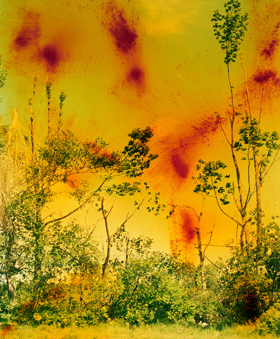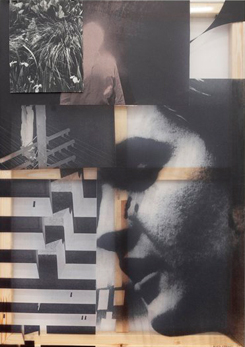Photography as Experiment
John Haberin New York City
Wolfgang Tillmans and Rachel Libeskind
Wolfgang Tillmans will try anything once, and then he will try again. It can make his images hard to pin down, but then there is always another like it. Make that a dozen more and counting.
It can make his sexuality hard to pin down, even by the poolside or on a dance floor. It can make the sexuality of others that much harder to pronounce, even as he closes in on them and strips them bare. It can make his media elusive, too. Is that a photo, a collage, or a copy? Who are you to say, and who is he? All you can know for sure is that everything for Tillmans is an experiment, and every experiment counts, at the Museum of Modern Art—and, in the galleries, Rachel Libeskind continues to probe photocollage, truth, and transparency. 
Try and try again
More than any photographer I know, Tillmans is incapable of composition. It is not the decomposition of a city in motion for Jamel Shabazz or William Klein. He loves motion, to be sure—of the dance, the surf, birds in flight, or no more than a tic. On video, he can focus on a steaming pot of peas for longer than you care to look, hoping to find the rhythm in the chaos. He covers a wall with fifty-six images of a Concorde jet, as fast as an airplane can get. Still, the pot is going nowhere, and the take-offs and landings are little more than a disappearing act.
Nor is it the banality of a selfie, although he photographs himself in the shower. Don't try this at home—at least if you value your camera? No matter, for he can always go digital and throw that old SLR away. He does not fall for trite compositions, but rather for no composition at all. It is all part of the flow of experience and the experiment. If he fails to capture either one, he can always try again.
Besides, he will have kept you on edge while he tries. Just outside his retrospective, as if left there by mistake, he shows two friends at rest in Victoria Park, in London. If it looks grainy and drab, it is only an inkjet print and only another day. Beside it, a video lingers over the twitch in a leg, and it, too, is going nowhere fast. But then he calls a series on the dance floor, in 1992, his Chemistry Squares, because photography, too, is only an experiment. One cannot know the dancers from the dance because one cannot know either one.
One might look for something more, beyond or behind the experiment. Could the two men in the park play on Déjeuner sur l'Herbe (or Luncheon on the Grass) by Edouard Manet? Tillmans must admire Manet's challenging sexuality, but do not ask for too much. One might see something more in a third and last image on the way to his show, a sheep nestled into its shadow#8212;two sheep at that, artfully blending into one. Still, it seems not so much art photography or artful photography as a photographer thinking aloud: "can I do that?"
It is also just one medium among many, like that inkjet print. Other artists have explored the potential of film and video for collaboration and stillness, like Gary Hill and Andy Warhol, or interactive motion, like Daniel Rozin and Lynn Hershman. For Tillmans, though, everything counts as new media, and everyday devices keep getting newer. Born in Germany in 1968, he had a breakthrough not with the discovery of photography, but at a copy shop. He marveled at how a copy machine turns the analog image into a digital signal and back. He must have admired still more how it can reduce a plain image to indecipherable streaks.
His retrospective has plenty of just that. His copies recall ghostly abstractions popular now or Jasper Johns prints. Later, he makes abstract photography on a larger scale. He has approached still life, portraiture, fashion photography, and photojournalism, too, without quite falling for any one. He gets the entire sixth floor, like Donald Judd before him, for well over three hundred works. No single image is a killer, but stick with it. It may leave you exhausted, frustrated, or in awe.
Study or truth?
It may not look all that fearless, but MoMA calls its retrospective "To Look Without Fear." And there can be no doubt about his convictions. Tillmans made his Chemistry Squares for a magazine devoted to youth culture—and another early series to a magazine's issue on sexuality. His self-portraits in the shower and at poolside are his coming out. Later he creates a Truth Study Center of clippings and forgeries in glass cases. As a study center, it invites one to come to one's own conclusions, but it still claims the truth. And his truth runs to all the right subjects for a progressive in 2006, like gender, climate, inequality, and "the moral rot of this cursed war."
Still, once again do not ask for too much. He rarely makes sexuality explicit, and the study center has no narrative order. He is more concerned for the flow of experience. When his art does go to war, in 1999, he collects newspapers that show soldiers at leisure, taking what pleasure they can. He is drawn less to music and dance than to stacked speakers and empty clubs. And the show ends with another after party, reflected in mirrored walls by Isa Genzken, along with you.
Tillmans prefers the indecipherable or barely decipherable image. He uses photosensitive paper without a camera to capture a cigarette lighter and the flame. He closes in on headlights, dirt, drops of water, and a Shanghai Night. Other abstractions look like jellyfish or strings. The most explicitly political series, starting in 2008, depicts the flow of finance and the movement of peoples, but with little of hint what has made them centers of power or refugees. They become instead a portrait of the planet in motion and the passage from motion to rest.
The less distinct they become, the more they show the photograph as itself an object. For Tillmans, photos have always been like that, "as extremely flat cubes." He adds folds for the sake of creases, and he photographs postcards on a sill spilling onto the floor. At the same time, objects seem weightless, just as no one image carries much weight. As technology evolves before his eyes, photography comes to belong to and to depict a world of pixels. It is good that he caught a clunky photocopier while he still could.
The curators, Roxana Marcoci with Caitlin Ryan and Phil Taylor, turn the retrospective into an object as well. It proceeds by chronology and by subject, but not in a long row. Series hang in grids, and small photographs hang beside large ones. You get to decide which deserve the most attention. Videos have their own dark rooms, like theaters, but soundproofing could pass for an artwork itself. At the end, one must fine one's way around the mirrored wall.
Anything can catch this photographer's eye, from the the headlines and the earth to distant planets. For all the claims of the study center, anything here is only a partial truth. His breadth has earned critical praise, where you may see only a short attention span. One might do better to see curiosity and a continued experiment. Tillmans comes back to the shower after nearly thirty years and to a self-portrait in 2020. Anything will return, in some form or another, if only you open your eyes and wait.
Seeing through art
For a show of "Transparent Things," Rachel Libeskind sure keeps one guessing. Are those faces, and how could I not have seen them sooner? Just who is walking in shadow on such a sunny day? And what accounts for all those eyes? Are they hers, a portrait's, a shadowy onlooker's, or your own? Art is all about looking, but not often like this.
 Transparency in government does not come easy, but transparency in art may be a still more distant ideal. It lies behind the good old metaphor of art as a window onto nature. It lies behind the mantra of Minimalism, what you see is what you get. And still art keeps one looking and guessing. Libeskind does—and not just because of the enigmas of her images and their juxtaposition, but also because of how long they stick in the mind. As the silhouette of a man crosses the horizon in sunlight, another sinks further into shadow to his side, and a tiger leaps forward beneath them both. But what are they pursuing?
Transparency in government does not come easy, but transparency in art may be a still more distant ideal. It lies behind the good old metaphor of art as a window onto nature. It lies behind the mantra of Minimalism, what you see is what you get. And still art keeps one looking and guessing. Libeskind does—and not just because of the enigmas of her images and their juxtaposition, but also because of how long they stick in the mind. As the silhouette of a man crosses the horizon in sunlight, another sinks further into shadow to his side, and a tiger leaps forward beneath them both. But what are they pursuing?
Claudio Parmiggiani, too, has in mind transparent things, while his own materials are anything but. Either way, he is seeing photography's ghosts, at Bortolami through October 29. He pictures tall glassware on horizontal supports, for the axes of a grid, but prints the images with smoke and soot. They do not so much soften the images as bring them closer to photograms or negatives—at once ghostly and a direct imprint of nature, the thing itself. While less successful, the occasional sculpture is grimier still. Transparency keeps becoming brighter and more obscure.
Libeskind's faces may be works of art with the eerie polish of Surrealism or classical sculpture, as iconic as Elvis, as clinical as an x-ray, or as immediate as the present. Bodies slip in and out of the picture, as in so much feminist art today. A Nazi soldier marching with his son belongs, no doubt, to history but may be the most chilling of all—not least for an artist based in Berlin. Collage itself can open onto private worlds, as for Joseph Cornell, or consumer culture, as for Robert Rauschenberg and Andy Warhol, with no space for privacy. Libeskind starts with actual collage on photosensitive materials before stripping it of color and converting it into, well, transparencies. And then red squares and yellow tints restore the picture plane even as they pop right out.
The most dominant image very much is an object. Quite a few artists now have turned a stretcher toward the viewer, making the back of a picture its front. Their goal is again transparency. It may make the process of art visible or stress that painting in two dimensions is as material as anything else. Libeskind, though, displays stretchers for their own sake, without canvas, and yet they are not up front. She covers them with her not quite transparent sheets, unstretched.
Sheets of what? Their variety, too, both affirms and eludes transparency. Libeskind prints on PVC, latex, silicone, fiberglass netting, you name it. Their cool images and black splatters may echo or efface the bars of a stretcher. She speaks of wanting to "enlighten, liberate, and destroy" the pieces. I still worry that I am missing something that you should hear, and I still wonder whether they add up. Still, her point may well be that a greater transparency is asking too much.

Wolfgang Tillmans ran at The Museum of Modern Art through January 1, 2023, Rachel Libeskind at Signs and Symbols through October 29, 2022.




